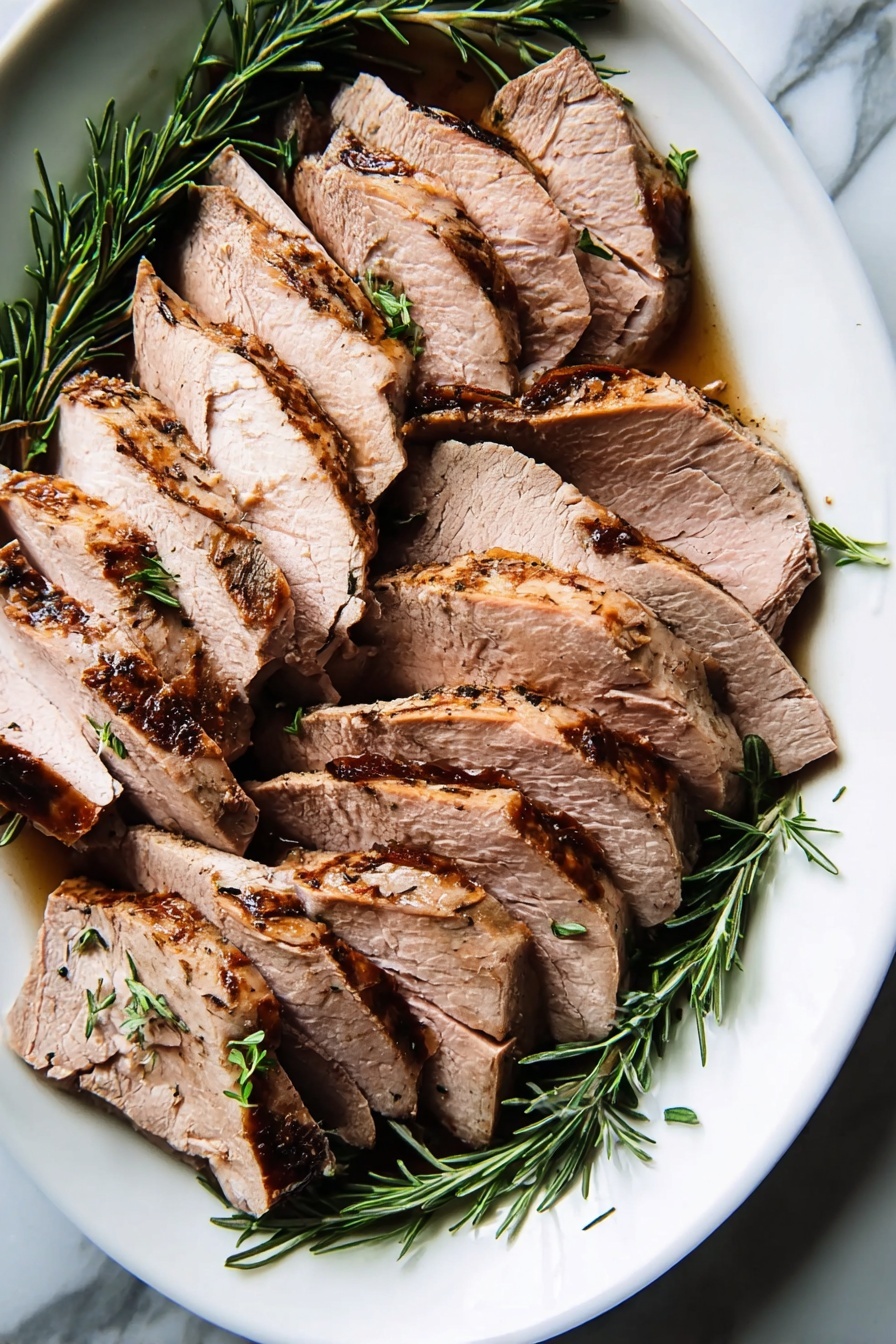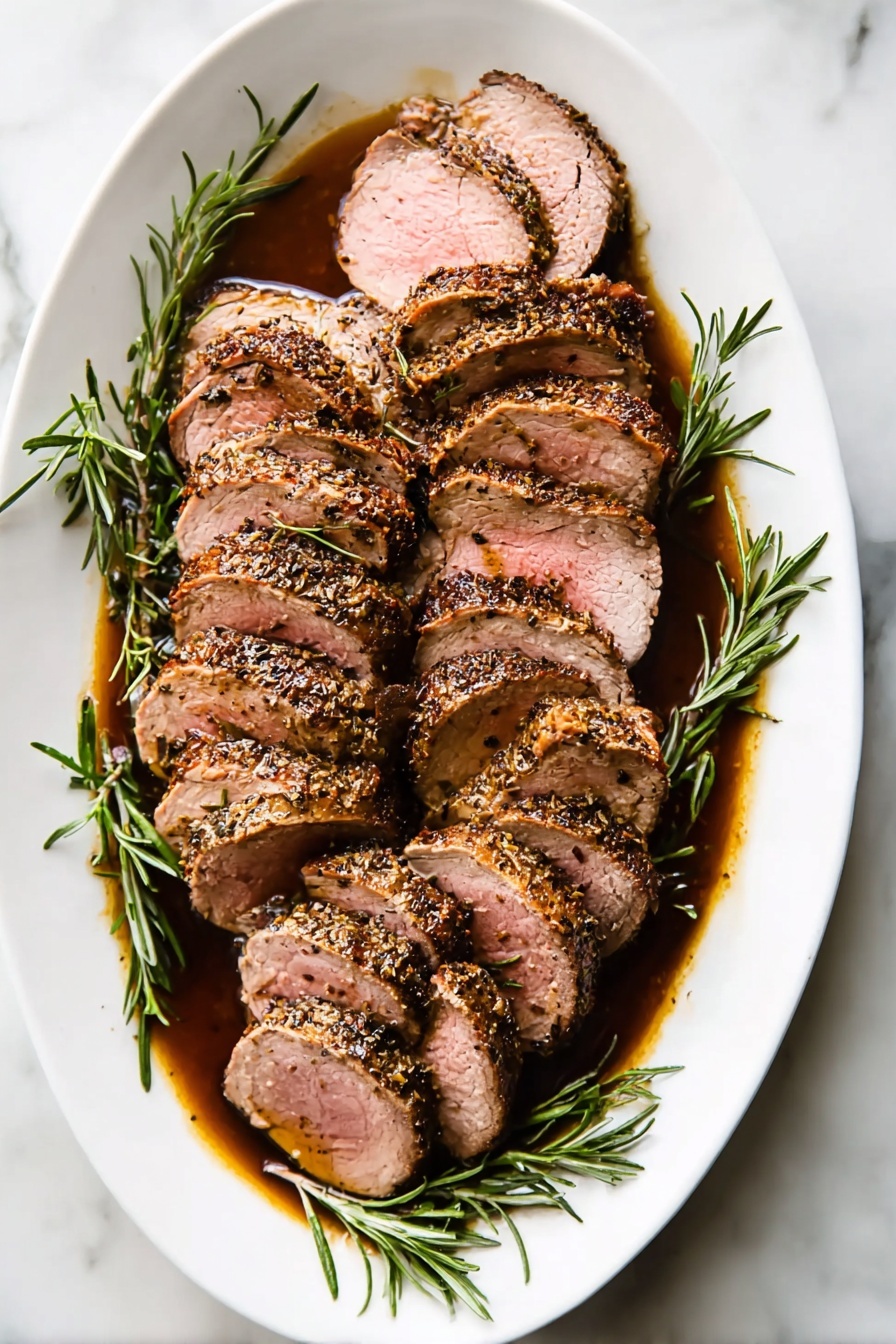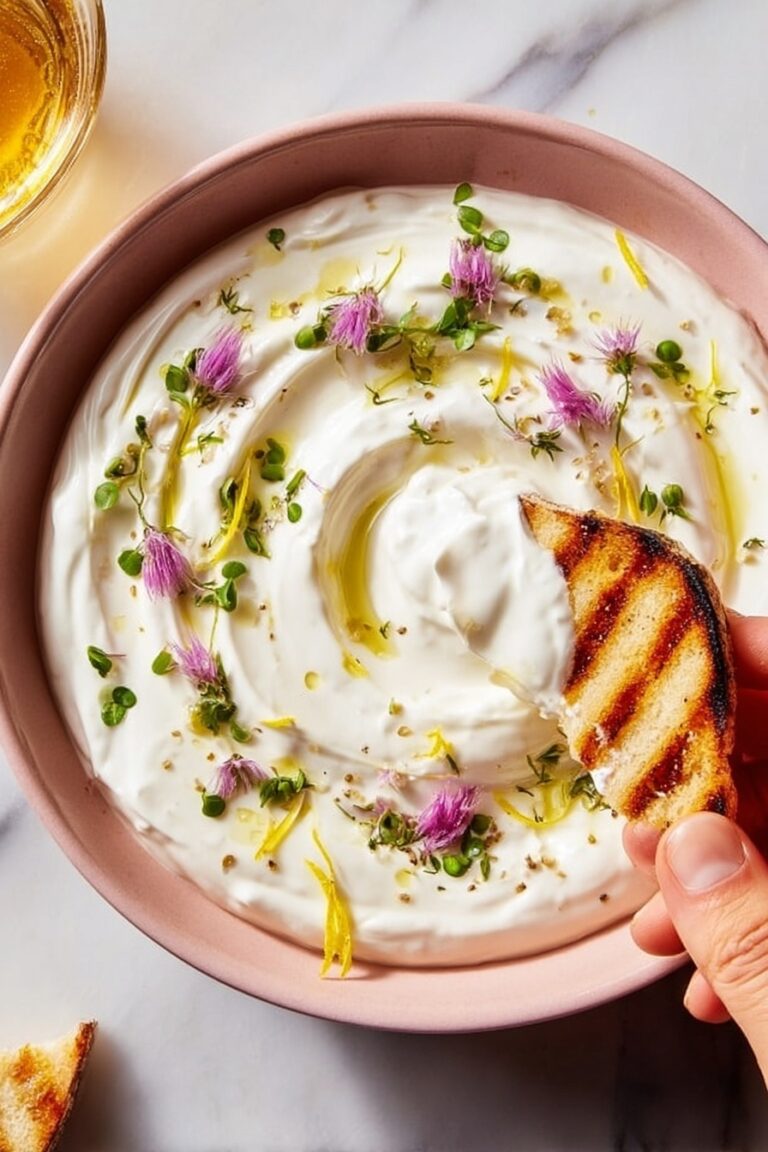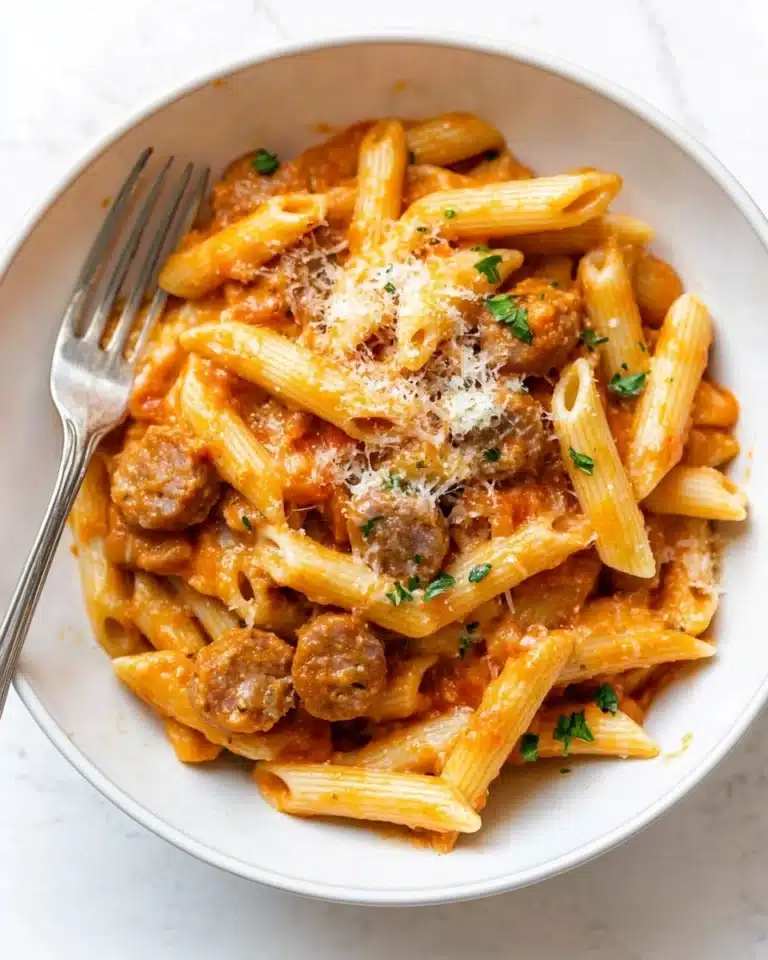If you’re looking for a show-stopping dish that combines rustic flavors with elegant flair, then you’re going to adore this Herb Crusted Pork Roast with Port Wine Sauce Recipe. It’s the kind of recipe I love because it’s approachable, yet feels fancy enough for guests or a cozy family dinner. The crust is packed with fragrant herbs and garlic, searing into the pork to lock in juicy, tender goodness, while the luscious port wine sauce adds a rich, silky finish that’ll have you swooning with every bite. Keep reading because I’m sharing all my best tips to make sure yours turns out perfect!
Why You’ll Love This Recipe
- Herb-Infused Crust: The fresh rosemary, thyme, and garlic create a flavorful crust that’s packed with aroma and taste.
- Perfectly Juicy Pork: Searing locks in the juices so the pork roast remains tender and delicious.
- Elegant Port Wine Sauce: The sauce is rich, slightly sweet, and velvety, elevating this roast to restaurant-quality.
- Surprisingly Easy: With straightforward steps and common ingredients, you’ll feel like a culinary pro.
Ingredients You’ll Need
This herb crust and port wine sauce combo work beautifully because the fresh herbs complement the pork’s mild flavor, while the red wine sauce adds depth and a touch of sweetness. When shopping, I like to pick the freshest rosemary and thyme I can find—those little leaves make all the difference. Also, a good quality port wine will really shine in this sauce.
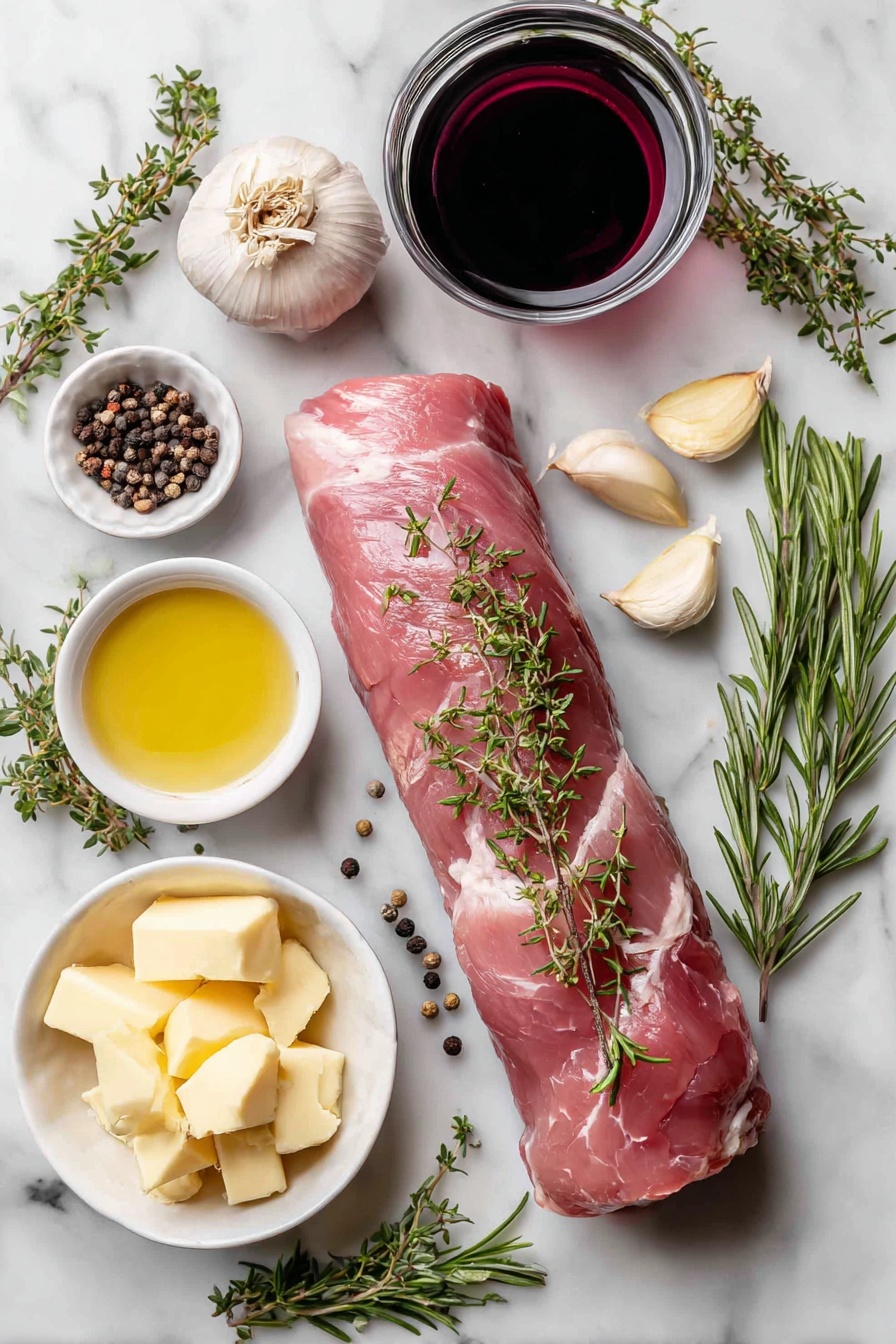
- Pork Tenderloin: Choose a 2-pound piece with even thickness for uniform cooking, and trim any extra fat for the best crust.
- Garlic Cloves: Fresh cloves deliver that punchy aroma and flavor you want; avoid pre-minced for this recipe.
- Fresh Rosemary: Using fresh herbs will give a vibrant flavor; dried won’t give you the same effect here.
- Fresh Thyme: The tiny leaves pack so much flavor; strip them from the stems for the crust.
- Whole Peppercorns: Grinding them fresh will release oils that add subtle heat and earthiness.
- Kosher Salt: Essential for seasoning well without overpowering, kosher salt dissolves nicely on the meat.
- Olive Oil: Use a good quality extra virgin for the herb paste and searing; it helps brown the pork nicely.
- Shallot: Adds mild onion sweetness to the sauce that’s softer and more elegant than regular onions.
- Port Wine: Sweet and rich, this red dessert wine thickens into a silky sauce and pairs naturally with pork.
- Butter: Cold butter whisked in at the end creates a beautiful velvety finish to the sauce.
Variations
I’m all about making recipes your own, so I love swapping a few elements here and there depending on the occasion or my mood. Feel free to experiment with herbs or tweak the sauce to suit your taste buds.
- Herb Swap: I once made this using oregano and sage instead of rosemary and thyme—gave it a warmer, earthier vibe that was just as delicious.
- Sauce Variation: Sometimes I add a splash of balsamic vinegar to the port wine reduction for a tangy twist.
- Spicy Kick: A pinch of crushed red pepper flakes in the herb crust adds a subtle heat that my family went crazy for.
- Diet-Friendly: You can omit the butter in the sauce and use olive oil for a lighter version that still feels indulgent.
How to Make Herb Crusted Pork Roast with Port Wine Sauce Recipe
Step 1: Create the Herb and Garlic Paste
Start by grinding your garlic, rosemary, thyme, and peppercorns into a thick paste using a mortar and pestle. If you don’t have one, a small food processor works perfectly—just pulse gently until you have a texture like a coarse paste. This paste is going to pack so much flavor into the crust, so don’t rush it. I discovered this trick when I first tried chopping herbs finely by hand and the flavor wasn’t nearly as intense.
Step 2: Prep and Rub the Pork
Trim any excess fat from your pork tenderloin and pat it dry with paper towels to ensure the crust sticks beautifully. Then slather the herb and garlic paste generously all over the pork on every side. Finish by seasoning the pork liberally with kosher salt—this helps balance the flavors and enhances the meat’s natural juices. Trust me, this step makes the difference between a bland roast and something extraordinary.
Step 3: Sear the Pork for Flavor and Texture
Heat 2 tablespoons of olive oil in an oven-proof skillet or braiser over high heat until shimmering. Carefully add the pork and sear it on all sides—about 3 minutes per side. You’re looking for a deep golden-brown color that seals in the juices and develops that incredible herb crust. This is the step where patience counts, so resist the urge to move it around too much. Once seared, transfer the skillet with the pork directly into the preheated oven at 375°F.
Step 4: Roast to Perfect Juiciness
Roast the pork for about 15-20 minutes, or until a meat thermometer inserted into the thickest part reads 140°F. This medium doneness keeps the pork juicy and tender, but feel free to cook slightly longer if you prefer it more well done. When it’s ready, remove the skillet and transfer the pork to a cutting board. Tent loosely with foil and let it rest for 10 minutes—this step lets the juices redistribute so every bite is perfection.
Step 5: Make the Port Wine Sauce
While the pork rests, place the same skillet back over medium-high heat and add 1 tablespoon of olive oil. Sauté the finely chopped shallots until they’re tender and translucent but not browned, about 2-3 minutes. Pour in the port wine along with the whole peppercorns and rosemary sprig. Let the liquid come to a low boil, then reduce the heat and simmer until the sauce has reduced by half. Make sure to scrape up the brown bits on the pan with a wooden spoon—that’s where all that incredible flavor lives.
Step 6: Finish the Sauce and Serve
Turn off the heat and whisk in the cold butter a tablespoon at a time. This will thicken the sauce and give it a luxurious sheen. Strain the sauce to remove the peppercorns, rosemary sprig, and shallot bits if you prefer a smoother finish. Slice the pork thinly and serve it with the warm port wine sauce drizzled over or on the side. I love plating this over creamy mashed potatoes to soak up that sauce—trust me, your guests will be asking for seconds!
Pro Tips for Making Herb Crusted Pork Roast with Port Wine Sauce Recipe
- Use a Meat Thermometer: I can’t stress this enough—internal temperature is the key to juicy pork. 140°F is your sweet spot.
- Don’t Skip Resting: Letting the pork rest after roasting locks in the juices and improves texture dramatically.
- Sear Well: A good sear is what creates that irresistible crispy herb crust; high heat and patience are essential.
- Port Sauce Reduction: Simmer gently and watch closely to avoid burning the sugars in the port wine—low and slow is best.
How to Serve Herb Crusted Pork Roast with Port Wine Sauce Recipe
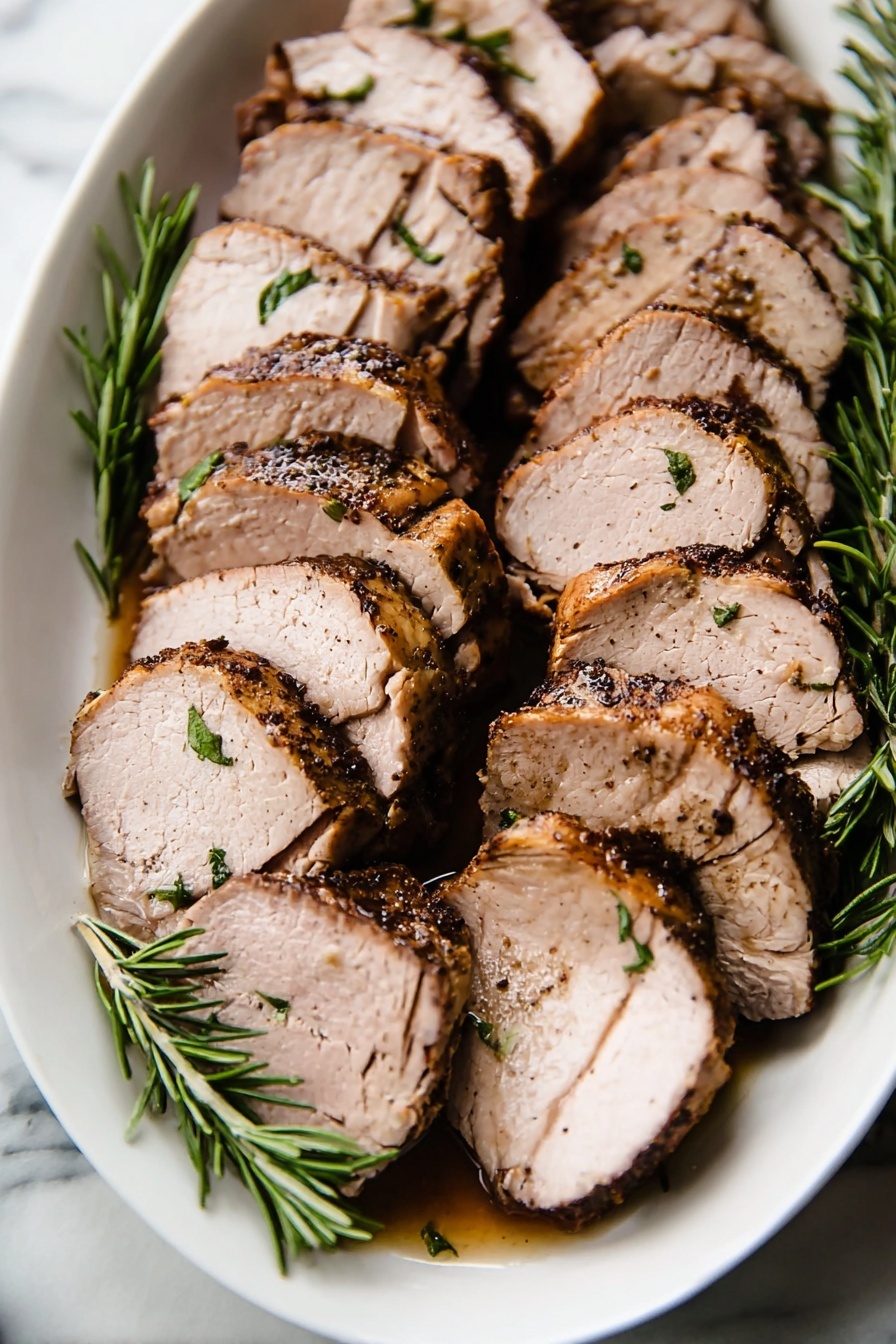
Garnishes
I typically garnish the roast with a few fresh rosemary sprigs and a sprinkle of freshly ground pepper—simple, but it brings freshness and looks pretty on the plate. Sometimes I add a little flaky sea salt on top right before serving for a satisfying crunch.
Side Dishes
Mashed potatoes are my all-time favorite pairing because they soak up that rich port wine sauce like a dream. Roasted garlic green beans or a simple arugula salad with lemon vinaigrette add the perfect balance to this rich dish. For a cozy dinner, creamy polenta is also wonderful.
Creative Ways to Present
If I’m serving this for a special occasion, I slice the pork roast and fan it out on a warmed platter, then drizzle the port wine sauce over just before serving. Adding a handful of pomegranate seeds and fresh herbs on top gives it a festive, colorful pop that really wows the eye.
Make Ahead and Storage
Storing Leftovers
I store leftover pork in an airtight container in the fridge, separated from the sauce to keep the crust from getting soggy. It will stay fresh for up to 3 days, which is plenty of time for me to rehearse enjoying it again.
Freezing
You can freeze the sliced pork and the port wine sauce separately in freezer-safe containers. I recommend freezing in meal-sized portions so you only thaw what you need. Both keep well for up to 3 months. When I freeze the sauce, I thaw it overnight in the fridge to keep that buttery texture intact.
Reheating
To reheat, gently warm the pork slices in a skillet over medium-low heat with a splash of water or broth to prevent drying. Heat the port wine sauce separately over low heat, whisking occasionally to bring back the smooth texture. Avoid the microwave if you can—it tends to dry out the meat and break the sauce.
FAQs
-
Can I use a different cut of pork for this Herb Crusted Pork Roast with Port Wine Sauce Recipe?
Absolutely! While pork tenderloin is ideal for its tenderness and size, pork loin roast can also work well. Just adjust the cooking times accordingly, as larger roasts take longer to reach the right temperature.
-
Is it necessary to strain the port wine sauce?
Straining the sauce is optional. I usually strain it for a smooth, elegant finish, especially if I’m serving guests. But if you enjoy the rustic texture of shallots and peppercorn bits, feel free to serve it as is.
-
What if I don’t have fresh herbs?
Fresh herbs give the best flavor and aroma, but if you only have dried rosemary and thyme, use them sparingly—about one-third the amount since dried herbs are more concentrated. The crust won’t be quite as vibrant, but still tasty!
-
Can I prepare the port wine sauce in advance?
Yes! The sauce keeps beautifully in the fridge for up to 36 hours. Just reheat gently before serving and whisk to bring it back to that velvety texture.
Final Thoughts
This Herb Crusted Pork Roast with Port Wine Sauce Recipe holds a special place in my dinner rotation because it’s delicious yet deceptively simple. When I first tried it, I was hooked by how the herbs and port wine brought out the natural sweetness of the pork. If you’re looking for a recipe that’s just as good for intimate dinners as it is for holiday celebrations, this roast will become one you turn to again and again. Give it a try—I’m confident it’ll be a new favorite in your kitchen!
Print
Herb Crusted Pork Roast with Port Wine Sauce Recipe
- Prep Time: 30 minutes
- Cook Time: 20 minutes
- Total Time: 50 minutes
- Yield: Serves 8
- Category: Main Course
- Method: Roasting
- Cuisine: American
Description
This Herb Crusted Pork Roast with Port Wine Sauce is a delicious and elegant dish perfect for special occasions or a comforting dinner. The pork tenderloin is coated in a fragrant garlic, rosemary, thyme, and peppercorn paste, seared to lock in juices, then roasted to tender perfection. The accompanying port wine sauce is rich and savory, with sweet and aromatic hints that pair beautifully with the pork and traditional mashed potatoes.
Ingredients
Pork Roast
- 4 garlic cloves
- 2 tbsp fresh rosemary
- 2 tbsp fresh thyme
- 2 tbsp whole peppercorns
- 2 lbs pork tenderloin
- Kosher salt, to taste
- 2 tbsp olive oil
Port Wine Sauce
- 1 tbsp olive oil
- 1 medium shallot, finely chopped
- 1 cup port wine
- 4-5 whole peppercorns
- 1 rosemary sprig
- 4 tbsp cold butter
Instructions
- Prepare Herb Paste: Using a mortar and pestle or a small food processor, grind the garlic, fresh rosemary, fresh thyme, and whole peppercorns into a thick, fragrant paste.
- Prepare Pork Tenderloin: Trim any excess fat from the pork tenderloin and pat it dry with a paper towel. Rub the garlic-herb paste evenly over all sides of the pork, then generously season with kosher salt.
- Sear the Pork: Heat 2 tablespoons olive oil in an oven-proof skillet or braiser over high heat until shimmering. Sear the pork tenderloin on all sides until nicely browned, about 3 minutes per side, for a total of around 12 minutes.
- Roast the Pork: Transfer the skillet with the seared pork to the oven preheated at 375°F. Roast until the internal temperature reaches 140°F, approximately 15-20 minutes. Remove the pork from the skillet onto a cutting board and tent loosely with foil to rest.
- Make the Port Wine Sauce: Place the same skillet back on medium-high heat and add 1 tablespoon olive oil. Sauté the finely chopped shallot until just tender to release its flavors.
- Reduce Wine and Finish Sauce: Pour in the port wine along with 4-5 whole peppercorns and a rosemary sprig. Bring to a low boil and reduce the liquid by half while scraping up browned bits from the bottom of the pan with a wooden spoon. Turn off the heat and whisk in 4 tablespoons of cold butter until the sauce is smooth and glossy.
- Strain and Serve: Strain the sauce to remove solids and allow it to cool slightly. Slice the rested pork roast thinly and serve with the port wine sauce on the side, ideally over creamy mashed potatoes for a complete meal.
Notes
- You can use a mortar and pestle or a food processor to prepare the herb paste; just ensure it’s a thick consistency for best adhesion to the pork.
- Use a meat thermometer to accurately check the pork’s internal temperature to avoid overcooking and keep it juicy and tender.
- The port wine sauce keeps well in the refrigerator for up to 36 hours and can be reheated gently.
- For an extra flavor boost, consider adding a splash of balsamic vinegar or a teaspoon of Dijon mustard to the sauce before adding the butter.
- This dish pairs wonderfully with mashed potatoes, roasted vegetables, or a simple green salad.
Nutrition
- Serving Size: 1/8 of recipe (about 3 oz pork with sauce)
- Calories: 320 kcal
- Sugar: 3 g
- Sodium: 350 mg
- Fat: 22 g
- Saturated Fat: 7 g
- Unsaturated Fat: 13 g
- Trans Fat: 0 g
- Carbohydrates: 5 g
- Fiber: 0.5 g
- Protein: 28 g
- Cholesterol: 85 mg

